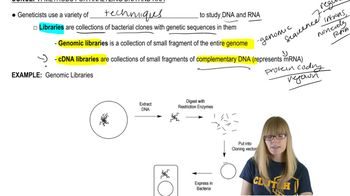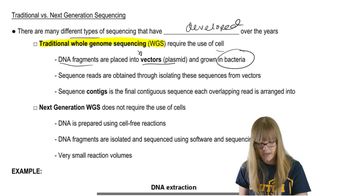Table of contents
- 1. Introduction to Genetics51m
- 2. Mendel's Laws of Inheritance3h 37m
- 3. Extensions to Mendelian Inheritance2h 41m
- 4. Genetic Mapping and Linkage2h 28m
- 5. Genetics of Bacteria and Viruses1h 21m
- 6. Chromosomal Variation1h 48m
- 7. DNA and Chromosome Structure56m
- 8. DNA Replication1h 10m
- 9. Mitosis and Meiosis1h 34m
- 10. Transcription1h 0m
- 11. Translation58m
- 12. Gene Regulation in Prokaryotes1h 19m
- 13. Gene Regulation in Eukaryotes44m
- 14. Genetic Control of Development44m
- 15. Genomes and Genomics1h 50m
- 16. Transposable Elements47m
- 17. Mutation, Repair, and Recombination1h 6m
- 18. Molecular Genetic Tools19m
- 19. Cancer Genetics29m
- 20. Quantitative Genetics1h 26m
- 21. Population Genetics50m
- 22. Evolutionary Genetics29m
15. Genomes and Genomics
Sequencing the Genome
Problem 4a
Textbook Question
How do cDNA sequences facilitate gene annotation? Describe how the use of full-length cDNAs facilitates discovery of alternative splicing.
 Verified step by step guidance
Verified step by step guidance1
<span>Understand that cDNA (complementary DNA) is synthesized from an mRNA template using the enzyme reverse transcriptase. This process captures the exons of a gene, which are the coding regions, and excludes introns, which are non-coding regions.</span>
<span>Recognize that cDNA sequences represent the expressed genes in a cell, providing a snapshot of the active genes at a particular time. This makes cDNA a valuable tool for gene annotation, as it helps identify which parts of the genome are transcribed into mRNA.</span>
<span>Full-length cDNAs are particularly useful because they represent the entire mRNA transcript, including the 5' and 3' untranslated regions (UTRs). This comprehensive representation aids in accurately annotating the start and end of genes.</span>
<span>Alternative splicing is a process where a single gene can lead to multiple mRNA variants, resulting in different protein isoforms. Full-length cDNAs can reveal these variants by showing different exon combinations in the cDNA sequences.</span>
<span>By comparing full-length cDNA sequences to the genomic DNA, researchers can identify alternative splicing events, such as exon skipping, alternative 5' or 3' splice sites, and intron retention, thus enhancing our understanding of gene complexity and regulation.</span>
Recommended similar problem, with video answer:
 Verified Solution
Verified SolutionThis video solution was recommended by our tutors as helpful for the problem above
Video duration:
1mPlay a video:
Was this helpful?
Key Concepts
Here are the essential concepts you must grasp in order to answer the question correctly.
cDNA (complementary DNA)
cDNA is synthesized from messenger RNA (mRNA) through the process of reverse transcription. It represents the coding sequence of a gene without introns, making it a valuable tool for studying gene expression and function. By analyzing cDNA sequences, researchers can identify which genes are actively expressed in a particular cell type or condition, aiding in gene annotation.
Recommended video:
Guided course

Methods for Analyzing DNA and RNA
Gene Annotation
Gene annotation involves identifying the locations and functions of genes within a genome. This process includes determining the structure of genes, such as exons and introns, and their regulatory elements. cDNA sequences play a crucial role in gene annotation by providing a clear picture of the expressed regions of genes, which helps in accurately mapping and characterizing them.
Recommended video:
Guided course

Mapping Genes
Alternative Splicing
Alternative splicing is a process by which a single gene can produce multiple mRNA variants by including or excluding certain exons during transcription. This mechanism allows for increased protein diversity and regulation of gene expression. Full-length cDNAs are essential for discovering alternative splicing events, as they capture the complete mRNA transcript, enabling researchers to identify different splice variants and their functional implications.
Recommended video:
Guided course

Alternative DNA Forms

 8:55m
8:55mWatch next
Master Sequencing Overview with a bite sized video explanation from Kylia Goodner
Start learning




